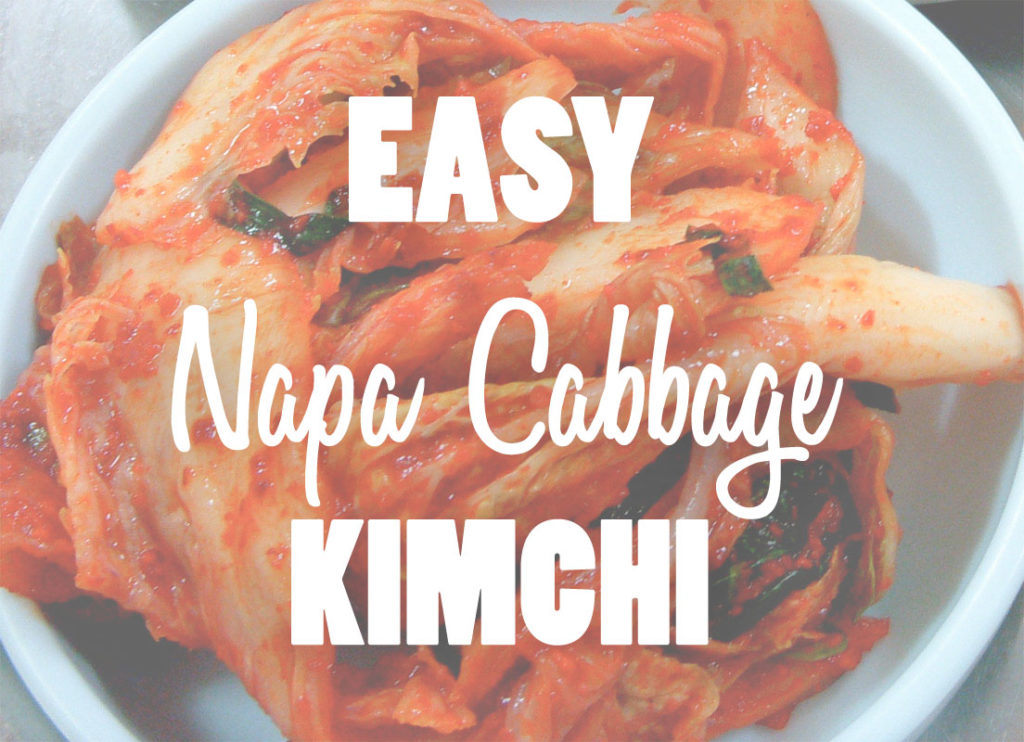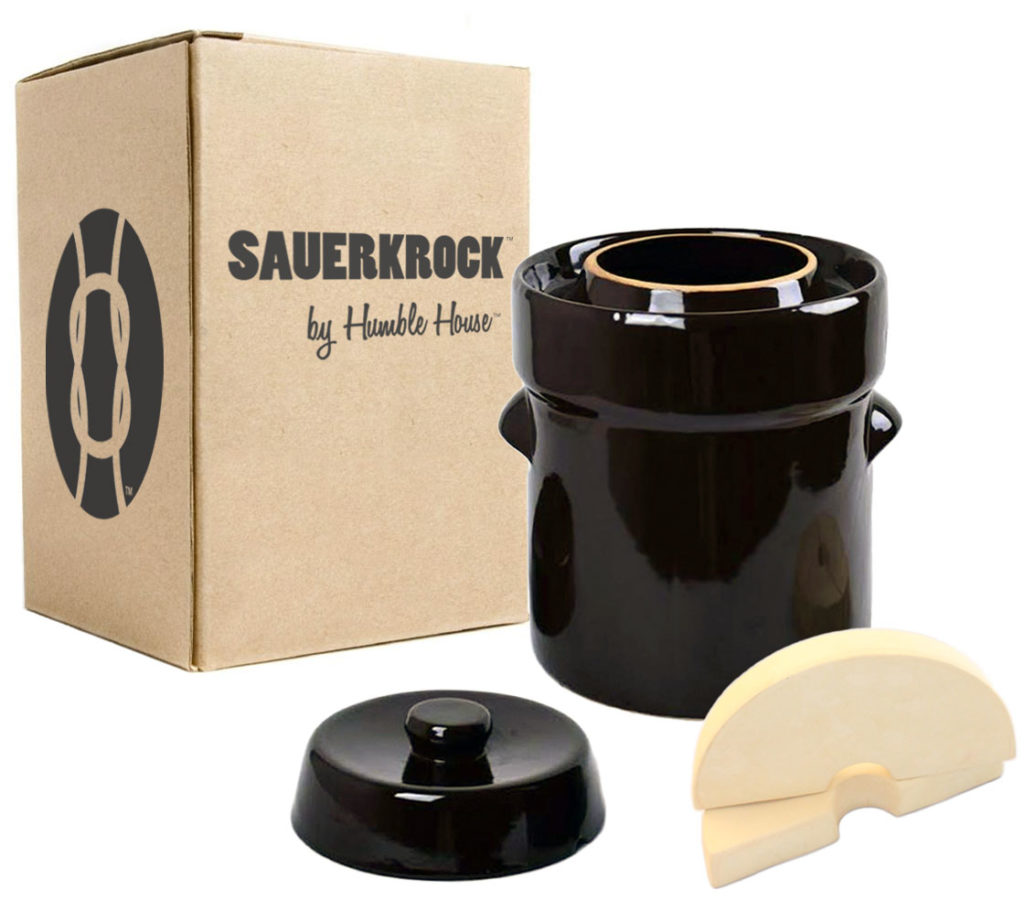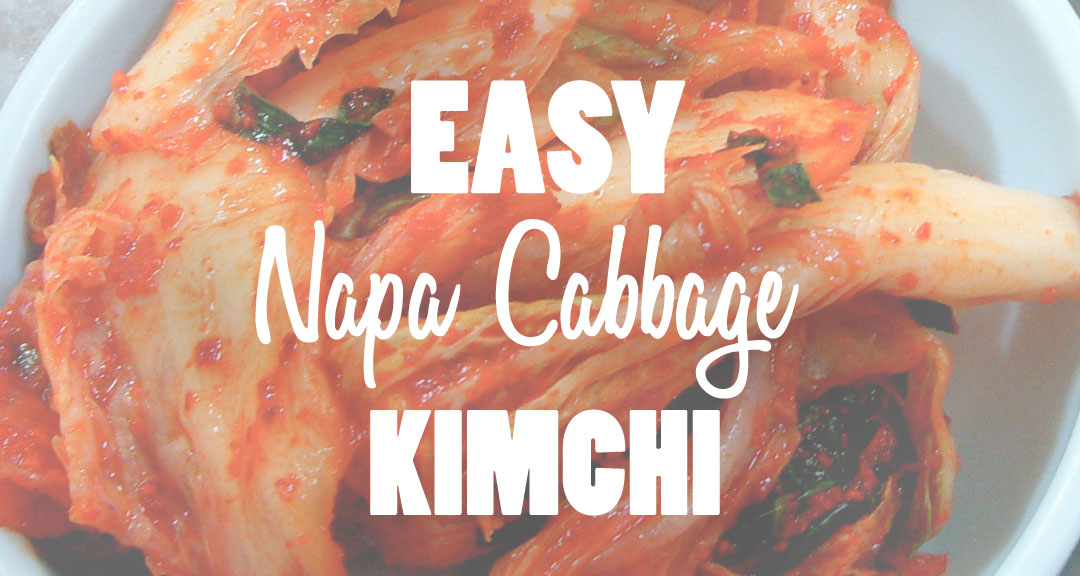
SO… WHAT EXACTLY IS KIMCHI?
Napa Cabbage Kimchi is a traditional fermented side dish native to Korea. It is made with a variety of vegetables and seasonings, most notably napa cabbage and Korean red pepper powder known natively as gochugaru. These ingredients go through lacto-fermentation, the same process used to make dill pickles and sauerkraut, to make traditional Kimchi.
Napa Cabbage Kimchi and other fermented foods have seen a huge surge in popularity thanks to recent research on the health benefits of probiotics for digestive health, among other areas. And thanks to the continued production of ceramic fermentation crocks, you can still make your fermented foods in the same traditional style that has been used for hundreds of years.

SPECIAL EQUIPMENT
MIXING BOWLS: You’ll want one large (4 or 5-quart) and one small (1 or 2-quart) glass or stainless steel mixing bowl to combine the salt and cabbage before transferring to the fermentation crock. Stainless steel and glass are non-absorbent materials and will not impart any undesirable flavors into your vegetables like plastic. We like the largest and smallest bowls from this Pyrex set of bowls or this Cuisinart set of bowls. Both are great sets with lids that you will get a lot of general use out of in the kitchen for cooking, backing, and food storage!
FERMENTATION CROCK: We recommend that you use a traditional ceramic fermentation crock, like the SAUERKROCK by Humble House, instead of mason jars for all food fermentation recipes and we have documented the reasons for this in detail in this blog post. The main reason for this is that mason jars and other clear glass vessels allow light and UV rays in which can be harmful to the fermentation process cause damage to your fermenting food.
STORAGE JARS: After the Kimchi has completed the lacto-fermentation process, you will need to transfer it over to mason jars for refrigerator storage. We’ve found that wide mouth mason jars make for the easiest transition and best storage solution and recommend either the quart-size like these ones or half-gallon size like these ones. The Kimchi produced by this recipe should fit in approximately one quart-size jars.
PLASTIC GLOVES: Gloves are totally optional, but we recommend food grade disposable poly gloves like these ones if you don’t want your hands to sting from massaging the salt into the napa cabbage!
REQUIRED INGREDIENTS
Makes approximately 1 liter of Traditional Napa Cabbage Kimchi
- Sauerkrock “City” = 2 liters (recommended fill is 1.5 liters)
- Sauerkrock “Original” = 5 liters (recommended fill is 4 liters)
- Sauerkrock “Family” = 10 liters (recommended fill is 8 liters)
We recommend visiting an Asian supermarket for a one-stop shop to pick up the required ingredients.
- 1 (2 pounds) napa cabbage
- 1/2 cup mineral-rich dry salt*
- Cold water**
- 1 (1 pound) daikon radish
- 4 medium scallions
- 1/3 cup Gochugaru / Korean red pepper powder (more or less to spice tolerance)
- 1/4 cup ginger root
- 1 bulb (6-8 cloves) garlic
- 1 tablespoon Fish Sauce
- 1 tablespoon Korean salted shrimp (found in refrigerated section)
- 1 teaspoon granulated sugar
*We do not recommend using standard table salts or kosher salts because they are refined and often contain anti-caking agents. The best salts we’ve used for making Napa Cabbage Kimchi and other fermented foods are Real Salt brand sea salt and varieties of Pink Himalayan Salt. These salts are natural and unrefined which means they contain no artificial ingredients and maintain all of their original minerals which add to the quality and flavor of your recipe.
**Tap water is treated with chlorine and other chemicals that inhibit the growth of both bad and good bacterias. If you plan on using water from the faucet, make sure to run it through a charcoal filter to strip it of chemicals. You can also use natural spring water as another alternative.

RECIPE INSTRUCTIONS
PREPARE THE CABBAGE
Cut the cabbage into quarters lengthwise, then trim out and discard the core. Next, cut the cabbage crosswise into 2-inch-wide strips and place them in a large bowl with the salt. Massage the salt into the cabbage with your hands (wear gloves if desired) until it is noticeably softer to touch, then fill the bowl with filtered water until the cabbage is mostly covered. Weigh the cabbage down using your fermentation weights so that it is completely submerged and cover with plastic wrap.
After letting stand at room temperature for 12 to 24 hours, thoroughly rinse the cabbage with cold water and let it drain in a colander for 15-20 minutes.
PREPARE THE REMAINING INGREDIENTS
While waiting for the cabbage to drip dry, peel the daikon radish then cut it into 2-inch matchsticks. Trim off the scallions ends then cut into 1-inch pieces. Combine the radish and scallions in the large bowl. In a separate small bowl, combine the minced salted shrimp, peeled and minced ginger, minced garlic cloves, gochugaru, fish sauce, and sugar and stir until you achieve a smooth paste.
COMBINE ALL INGREDIENTS
After the cabbage has been given time to dry out, transfer it back to the large bowl with the other vegetables, hand squeezing out the excess water beforehand. Pour the paste into the large bowl, then massage the paste thoroughly into the vegetables with your hands until they are fully and evenly coated.
FERMENT THE MIXTURE
Transfer the finished mixture into your cleaned out fermentation crock then pack it down with cabbage tamper. Make sure the crock is filled no more than 3/4 full in order to leave room for the ceramic weights.
Set the weights on top of the mixture to ensure it stays submerged in the brine that develops during the lacto-fermentation process. Place the lid on the crock, fill the water channel water, then tuck the crock away in a low-traffic area (like the inside corner of a kitchen countertop) in order to avoid being disturbed while it ferments.
Let the mixture sit in the crock at room temperature for anywhere from 24 to 48 hours depending on your umami flavor tolerance. Don’t forget to check the water channel regularly to ensure enough water remains after evaporation to keep a seal.
CAN, REFRIGERATE, AND ENJOY
Move the fermented Napa Cabbage Kimchi into the wide mouth mason jar and refrigerate it, waiting at least 48 hours after first refrigeration before eating for best taste. Next step? Enjoy! Napa Cabbage Kimchi usually tastes best if eaten within the first two weeks of refrigeration but can last up to a month or longer due to the preserving power of lacto-fermentation.
DO YOU HAVE QUESTIONS, SUGGESTIONS, OR REQUESTS? LEAVE A BLOG COMMENT BELOW!


I made this recipe for Kimchi and it came out great. I did reduce the gochugaru and used cauliflower instead of daikon radish because daikon wasn’t available in our small town. We also didn’t have the shrimp so I increased the fish sauce a bit. I also added a couple of carrots sliced thin. I left it to ferment in our sauerkrock for 5 days and ended up with 3 pints of kimchi. I Really the whole process and the kimchi is so good. It’s hard to find good kimchi where we live so this is really a blessing. Next I’m going to try making the pickles. thanks so much
Hi Bruce,
Thank you for letting us know how the recipe turned out for you! We’re so glad you had success with it and were able to find suitable substitutes when you weren’t able to source some of the more specialty ingredients locally. We are in the process of locating a reputable online retailer for the salted shrimp specifically that we can refer our customers to and and will add it to the post when we find one. A large number of our customers live small towns and more rural areas so your tips will come in handy for any of them wanting to try their hand at this recipe!
The Sour Garlic Dill Pickles recipe is another one that we love, and we just added a Basic Black Tea Kombucha recipe. We have several more fermented food and beverage recipes lined up to launch in the next few months so be on the look out for more to come!
The Humble House Team
I have followed the recipe exactly, but I am questioning how I know it has fermented enough, what should it look like or smell? Mine has been fermenting for 48 hours, but it has not visibly changed as far as I can tell. The first commenter said hers fermented for 5 days. Mine is in a room near a window and it has been cold here the last few days. Does that make a difference? Thank you
Hi Johnnie,
In general, you want to start the ferment at two days and go up to a week or so depending on how strong a flavor you want. Additionally, the ferment should be at room temperature so the batch by a colder window is possibly affecting your ferment and slowing things down. We would suggest moving the batch further from the window and then checking in a day or two.
Hope that helps!
Happy Fermenting!
The Humble House Team
Thank you, for your quick response
No worries Johnnie!
I made the kimchi following the recipe except for the Gochugaru which I could not find instead added some cayenne pepper. After a couple of days I tasted it and it was extremely salty, left a couple more days more then took it out of the crock and put in mason jar. I tasted it today and not as salty but more than I would like. What did I do wrong, should I decrease the amount of salt?
Hi Marion,
If you wanted to attempt to make batches in process less salty, we would recommend diluting it slightly with a little more cabbage, perhaps a little bit of some other vegetable like radish, and a bit of water. However, since you already put this batch in mason jars, the batch may not turn out well if you return to the crock and attempt further fermentation due to the amount of exposure it has already had.
If the way this batch turned out for you was too salty, then we would recommend adding a little more vegetables as suggested above and a little less salt next time. Additionally, in general, the more salt you use, the longer the fermentation process takes.
We hope that helps and let us know if you have any further questions!
Happy Fermenting,
The Humble House Team
Can I substitute red pepper paste for the powder? Also, I have the 2 quart crock, would you suggest I half the recipe? Thanks!
Hi Donna,
You can use the paste and should be able to get a similar heat, but we would still recommend Gochugaru.
As 2 quarts is about 2L (.5 Gallon) , roughly halving the recipe should work though you should be able to fit a small cabbage head into the crock once cut up.
Happy Fermenting,
The Humble House Team
Just put the batch on to ferment… I am a little confused though. There isn’t a brine to submerge the kimchi. Is that supposed to develop on its own? It’s literally the vegetables and paste packed into the crock. Should I be concerned? Add water to keep it submerged?? Any advice is appreciated.
Hi Donna,
Thank you for your question! No worries, and no need to add water. The Kimchi will not have a brine when you first create the mixture but it will develop over time. Placing the weights on top of the mixture and pressing down initially will help ensure that the contents remain submerged as the brine develops.
Let us know if you have any other questions!
The Humble House Team
Would you, could you please identify the size of the crock that is being used in your recipes. That way people who have larger (or smaller) can adjust to what they have.
Hi Udo,
We appreciate your recommendation! This is a great point as all of our recipes produce different quantities. We have added the different Sauerkrock capacities, and our recommended fill amounts, on each of the recipe posts to help you and others appropriately convert recipes to fit to your own crock size.
We love hearing from our customers on ways we can improve our website so let us know if you have any other suggestions!
The Humble House Team
You guys are FAST! Thanks!
Hi, I have a 5L crock, does this mean I used 5 heads of cabbage?
I’m obviously missing something. How do I make the paste when the only wet ingredient listed is a tablespoon of fish sauce. Am I supposed to add water to the powder and other paste ingredients until the desired consistency? Thanks
Kimchi is one of the best things to ever come out of Korea. I eat it with everything.
Can this Kimchi be canned in clear mason jars? If so, what would be the instructions?
Thanks.
Any suggestions for making this vegan?